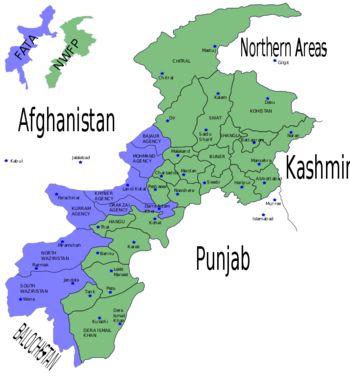Federally Administered Tribal Areas: Difference between revisions
Jump to navigation
Jump to search

imported>George Swan m (reformat) |
imported>George Swan (subpages) |
||
| Line 1: | Line 1: | ||
{{subpages}} | |||
{{Image|NWFP FATA.png|right|350px|The blue portion of this map shows Pakistan's seven semi-autonomous Tribal Agencies.}} | {{Image|NWFP FATA.png|right|350px|The blue portion of this map shows Pakistan's seven semi-autonomous Tribal Agencies.}} | ||
Along [[Pakistan]]'s border with [[Afghanistan]] Pakistan exercises a measure of authority over '''Pakistan's Tribal Agencies'''.<ref name=NYTimes2002-12-26> | Along [[Pakistan]]'s border with [[Afghanistan]] Pakistan exercises a measure of authority over '''Pakistan's Tribal Agencies'''.<ref name=NYTimes2002-12-26> | ||
Revision as of 13:48, 17 February 2009
Along Pakistan's border with Afghanistan Pakistan exercises a measure of authority over Pakistan's Tribal Agencies.[1] Most of the population of the seven Tribal agencies are traditional, conservative muslims. The agencies are: the Bajaur Agency, the Mohmand Agency, the Khyber Agency, the Orakzai Agency, the Kurram Agency and North Waziristan and South Waziristan.
Most of the tribes in the Tribal Agencies are Pashtun -- the same ethnic group that was the Taliban's power base in Afghanistan.[1] It is widely speculated that Osama bin Laden escaped Afghanistan at a border crossing into one of the Tribal Agencies.
References
- ↑ 1.0 1.1 David Rodhe. PAKISTAN TRIBAL REGION; An Anti-U.S. Haven for Al Qaeda, New York Times, 2002-12-26. Retrieved on 2009-02-11.
